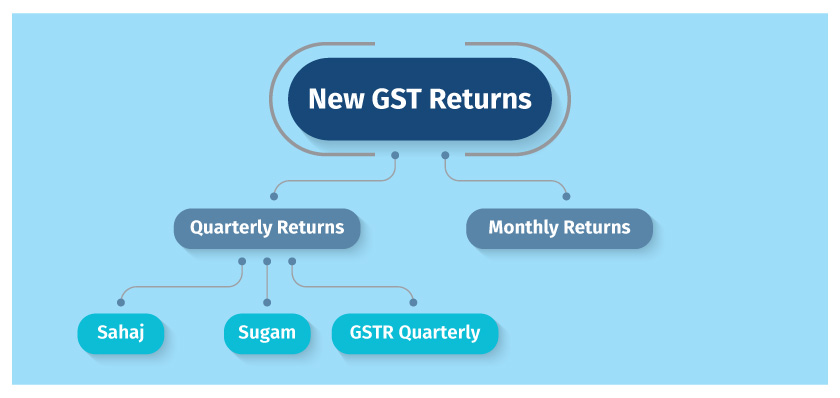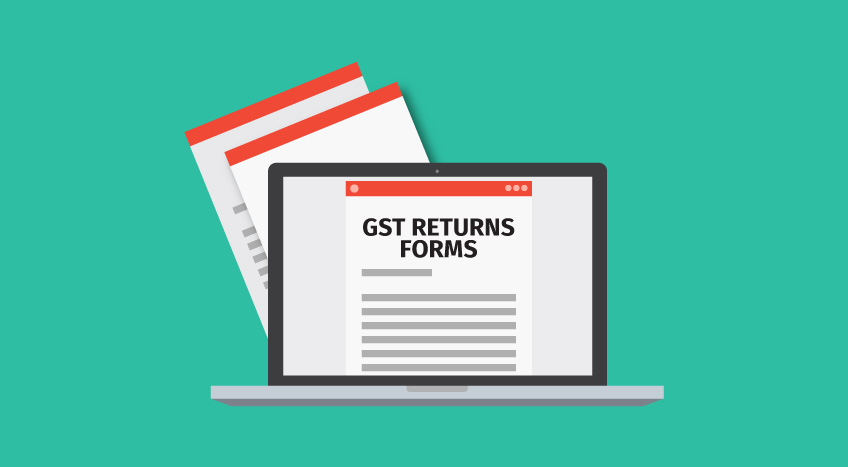Yarab A |Updated on: January 10, 2022
In order to simplify the GST return filing process, the GST council meeting held on 21st July, 2018 has approved the new GST returns. Different new and simplified GST return forms have been introduced considering the diversity of businesses operating in the country.
In another way, you must have heard the famous quote ‘One Size Does Not Fit All’. This is exactly the same reason for having simplified GST return forms. Based on the size the businesses, the type of supplies, the customers you deal with and the geography, the GST council has designed different type of new GST returns which will simplify the GST return filing process each of type of business instead of having a common GST return format for all.
New GST return forms
In this article, we will understand the different types of new and simplified GST return forms which are approved by the GST Council.

As illustrated above, broadly the new GST returns are classified into quarterly returns and Monthly returns. Again, the quarterly returns are further classified into Form GSTR Sahaj, Form GSTR Sugam and GSTR quarterly.
Worried! Because there are too many GST Returns forms to be filed?
No need to worry! You are not required to file all the forms illustrated above. Just like selecting the right size which fits you, you need to select one of the simplified GST return forms which suit your business profile.
Let us understand each of the simplified GST return forms in detailed.
Quarterly returns
The Registered businesses with the turnover up to 5 Cr in the previous financial year are allowed to opt for filing quarterly returns. However, the payment needs to be made on monthly basis and it will be a self-assessed basis. The input tax credit will be available only to the extent of invoices uploaded by the supplier. The quarterly returns will not have a concept of claiming ITC on missing invoices which are not uploaded by the supplier.
As illustrated above, quarterly returns consist of three different GST return forms which business can choose based on their profile.
Let us understand the different type of quarterly GST returns forms
Sahaj return
The businesses who often purchase only from the domestic market (within India) and their 100 % outward supplies are made to end consumers and unregistered business, known as B2C supplies can opt for GST return Form Sahaj.
The details of outward supplies are required to be captured at a summary level with a break-up of tax rate and place of supply. The details of ITC from inward supplies annexure which gets auto-populated based on the invoices uploaded by the supplier.
Businesses opting Sahaj should file quarterly return form known as “Form RET-2’
Sugam return
The Form GSTR Sugam can be opted by the businesses who supply to both B2B as well as B2C. This implies that businesses who make outward supplies to registered businesses (B2B), as well as end consumers or unregistered business (B2B), can opt for Sugam
The details of B2B supplies need to be captured at the invoice level in outward supplies annexure from where the details will be auto-populated to Form GSTR Sugam. The details of B2C supplies should be reported at a summary level in Sugam returns. Similar to Sahaj, the details of ITC will be auto-populated from inward supplies annexure based on the invoices uploaded by the supplier.
Businesses opting Sugam should file quarterly return form known as “Form RET-3’
Quarterly return
If you are business engaged in making exports including SEZ, B2B and B2C, you need to choose GST quarterly return form. The format of the quarterly form will be similar to monthly return form applicable to large taxpayers.
The details of B2B supplies along with exports need to be captured at the invoice level in outward supplies annexure from which the details will be auto-populated to Quarterly return form. The details B2C supplies should be reported at a summary level.
Here, the business will be allowed to claim ITC on missing invoices which are not uploaded by the supplier. The return filing process is similar to monthly return and will be filing return in Form RET-1
Monthly return
The Registered businesses with the turnover exceeding 5 Cr in the previous financial year should file the monthly return along with payment of tax. Here, the businesses are required to upload all the B2B invoices which in turn gets auto-populated in outward supplies annexure which inturn gets auto-captured in your monthly return.
ITC will be available on the invoices uploaded by the supplier with an option to claim and report the missing invoices which are not uploaded by the supplier. The monthly return along with the payment needs to be filed by 20th of the subsequent month.
The return form to be used for filing the monthly return is Form RET-01
Conclusion
The new and simplified GST return forms are designed keeping in mind the diversity of businesses operating in the country. The simplification in new GST return filing will be possible only when you chose the right type of new GST return suitable to your business. Therefore, it is utmost important for a business to carefully assess their vendors, type of supplies, customers etc. and chose the return which will simplify the compliance.
Read More on GST Returns
GST Returns, Types of GST Returns, Sahaj GST Returns, Sugam GST Returns, GSTR 1, GSTR 2, GSTR 3B, GSTR 4, GSTR 5, GSTR 5A, GSTR 6, GSTR 7, GSTR 8, GSTR 9, GSTR 10, GSTR 11
GST
GST Software, GST Calculator, GST on Freight, GST on Ecommerce, GST Impact on TCS, GST Impact on TDS, GST Exempted Goods & Services, Reverse Charge Mechanism in GST, GST Declaration
Types of GST
CGST, SGST, IGST, UTGST, Difference between CGST, SGST & IGST
GST Rates & Charges
GST Rates, GST Rate Finder, GST Rate on Labour Charges, HSN Codes, SAC Codes, GST State Codes
Latest Blogs

Nuts & Bolts of Tally Filesystem: RangeTree

A Comprehensive Guide to UDYAM Payment Rules

UDYAM MSME Registration: Financial Boon for Small Businesses

Understanding UDYAM Registration: A Comprehensive Guide

MSME Payment Rule Changes from 1st April 2024: A Quick Guide

Are Your Suppliers Registered Under MSME (UDYAM)?


